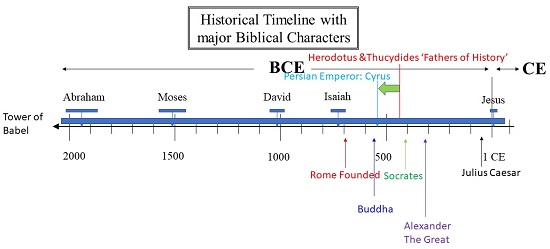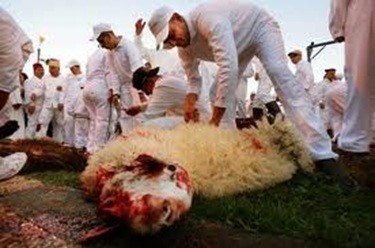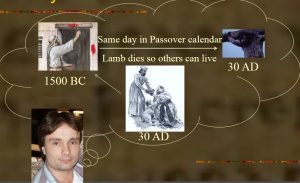Abraomui mirus , jo palikuonys buvo vadinami izraelitais. Po 500 metų jie tapo didele gentimi. Tačiau jie taip pat tapo egiptiečių vergais.
Išėjimas

Izraelio vadovas buvo Mozė. Dievas liepė Mozei eiti pas Egipto faraoną ir reikalauti, kad jis išvaduotų izraelitus iš vergijos. Taip prasidėjo faraono ir Mozės kova, sukėlusi devynis marus prieš faraoną ir egiptiečius. Nepaisant to, faraonas nesutiko paleisti izraelitų į laisvę. Taigi Dievas ketino atnešti mirtiną 10-ąjį marą. Spustelėkite čia, kad perskaitytumėte visą Biblijos 10-osios maro aprašymą.
Dievas įsakė, kad kiekvienas pirmagimis vyras žemėje tą naktį mirtų nuo Dievo mirties angelo. Tačiau gyvens tie, kurie liko namuose, kuriuose ant durų staktų nupieštas paaukotas ėriuko kraujas. Jei faraonas nepaklus, jo pirmagimis sūnus ir sosto įpėdinis mirs. Kiekvienas namas Egipte, kuris neaukotų ėriuko ir nepateptų jo krauju ant durų staktų, prarastų pirmagimį sūnų. Taigi Egiptas susidūrė su nacionaline nelaime.
Izraelitų (ir egiptiečių) namuose su ėriuko krauju pieštu ant durų buvo pažadėta, kad visi bus saugūs. Mirties angelas praeis pro tą namą. Taigi ši diena buvo vadinama Pascha .
Pascha – ženklas kam?
Žmonės mano, kad kraujas ant durų buvo skirtas tik Mirties angelui. Bet atkreipkite dėmesį, ką sako Biblija
13O kraujas ant namų bus ženklas, kur jūs gyvenate. Pamatęs kraują, aplenksiu jus, kad Egipto šalies bausmė nepaliestų jūsų.
Išėjimo knyga 12:13
VIEŠPATS ieškojo kraujo ant durų ir, jei jį pamatys, mirtis praeis. Bet kraujas Jam nebuvo ženklas. Sakoma, kad kraujas buvo „ženklas tau“ – žmonėms, įskaitant tave ir mane.
Bet kaip tai ženklas? Po to VIEŠPATS įsakė jiems:
27atsakykite: „Tai yra Paschos auka Viešpačiui, kuris aplenkė izraelitų namus Egipte, kai Jis išžudė egiptiečius ir išlaisvino mūsų namus.“ Tada žmonės nusilenkė ir pagarbino Viešpatį.
Išėjimo knyga 12:27
Įspūdingas Paschos kalendorius
Tiesą sakant, šios istorijos pradžioje matome, kad šis 10-asis maras pradėjo senovės izraelitų (žydų) kalendorių.
1Viešpats kalbėjo Mozei ir Aaronui Egipto šalyje:
2„Šitas mėnuo tebūna jums pirmasis metų mėnuo.
Išėjimo knyga 12:1-2
Nuo to laiko izraelitai pradėjo kurti kalendorių, pagal kurį kiekvienais metais tą pačią dieną švęsdavo Paschą. Tai pažymėjo jų naujus metus. 3500 metų žydai kasmet švenčia Paschą, kad prisimintų šį įvykį. Kadangi žydų kalendoriniai metai šiek tiek skiriasi nuo Vakarų kalendoriaus, Paschos diena kiekvienais metais perkeliama į Vakarų kalendorių.
Jėzus ir Pascha

Jei stebėsime Paschos šventes istorijoje, suprasime kai ką nepaprasto. Atkreipkite dėmesį, kada įvyko Jėzaus suėmimas ir teismas:
28Iš Kajafo rūmų jie nuvedė Jėzų į pretorijų. Buvo ankstyvas rytas. Jie patys nėjo į pretorijų, kad nesusiteptų ir galėtų valgyti Paschą.
Evangelija pagal Joną 18:18
Jie suėmė ir nužudė Jėzų būtent per žydų kalendoriaus Velykas. Tą pačią dieną visi žydai aukojo ėriuką, kad prisimintų tuos ėriukus 1500 m. pr. e. m. e., dėl kurių mirė mirtis . Prisiminkite iš Abraomo aukos , vienas iš Jėzaus titulų buvo:
29Kitą dieną Jonas, matydamas pas jį ateinantį Jėzų, prabilo: „Štai Dievo Avinėlis, kuris naikina pasaulio nuodėmę!
Evangelija pagal Joną 1:29
Jėzus, „Dievo Avinėlis“, buvo paaukotas tą pačią dieną , kai visi tuo metu gyvi žydai aukojo ėriuką pirmosios Paschos, kuri pradėjo savo kalendorių, atminimui. Štai kodėl žydų Pascha švenčiama tuo pačiu metu kaip Velykos . Velykos mini Jėzaus mirtį, o kadangi tai įvyko per Paschą, Velykos ir Velykos vyksta šalia. (Kadangi vakarietiškas kalendorius skiriasi, jie būna ne tą pačią dieną, o dažniausiai tą pačią savaitę).
Ženklai, ženklai, visur yra ženklai
Prisiminkite tą pirmąją Paschos šventę Mozės dienomis, kai kraujas buvo „ženklas“, aiškus mums. Pagalvokite, ką daro ženklai , atsižvelgdami į šiuos ženklus.

Kai matome ženklą „Kaukolė ir sukryžiuoti kaulai“, galvojame apie mirtį ir pavojų . „Auksinių arkų“ ženklas verčia susimąstyti apie „McDonalds“ . „√“ ant Nadalo juostos yra „Nike“ ženklas . „Nike“ nori, kad apie juos galvotume, kai tai matome Nadalyje. Ženklai kuriami tam, kad nukreiptų mūsų mąstymą ne į patį ženklą, o į tai, ką jis nurodo .
Dievas Mozei pasakė, kad pirmasis Paschos kraujas buvo ženklas . Taigi, ką Dievas nurodė šiuo ženklu? Nepaprastas laikas, kai ėriukai buvo paaukoti tą pačią dieną kaip Jėzus, „Dievo Avinėlis“, ženklas rodo ateinančią Jėzaus auką .
Du ženklai – nurodantys vietą ir datą
Tai veikia mūsų mintyse, kaip parodyta diagramoje.

Ženklas verčia susimąstyti apie Jėzaus auką. Per pirmąją Paschą izraelitai aukodavo ėriukus ir dažydavo kraują, kad mirtis apeitų juos. Šis ženklas, nurodantis į Jėzų, mums sako, kad taip pat buvo paaukotas „Dievo Avinėlis“ ir jo kraujas išsiliejo, kad mirtis mus aplenktų.
Abraomo aukos vieta , kur mirė avinas, kad Izaokas galėtų gyventi, buvo Morijos kalnas – ta pati vieta , kur Jėzus buvo paaukotas po 2000 metų. Tai leidžia mums „pamatyti“ jo aukos prasmę, nurodant vietą . Pascha taip pat nurodo Jėzaus auką, bet iš kitos perspektyvos. Jis nurodo kalendoriaus dieną – kalendorių, prasidėjusį nuo pirmosios Paschos . Dviem skirtingais būdais svarbiausios Senojo Testamento istorijos tiesiogiai nurodo Jėzaus mirtį naudojant aukotus ėriukus. Neįsivaizduoju jokio kito žmogaus istorijoje, kurio mirtis (ar gyvenimo pasiekimas) buvo numatyta dviem tokiais dramatiškais būdais. Ar gali?
Šie du įvykiai (Abraomo auka ir Pascha) turėtų mums parodyti, kad yra pagrįsta manyti, kad Jėzus yra dieviškojo plano centras .
Bet kodėl Dievas įdėjo šiuos ženklus į senovės istoriją, kad numatytų Jėzaus nukryžiavimą? Kodėl tai taip svarbu? Kam gi pasaulis reikalauja tokių kruvinų simbolių? Dievas parodo mūsų padėties beviltiškumą, kai duoda dešimt įsakymų .